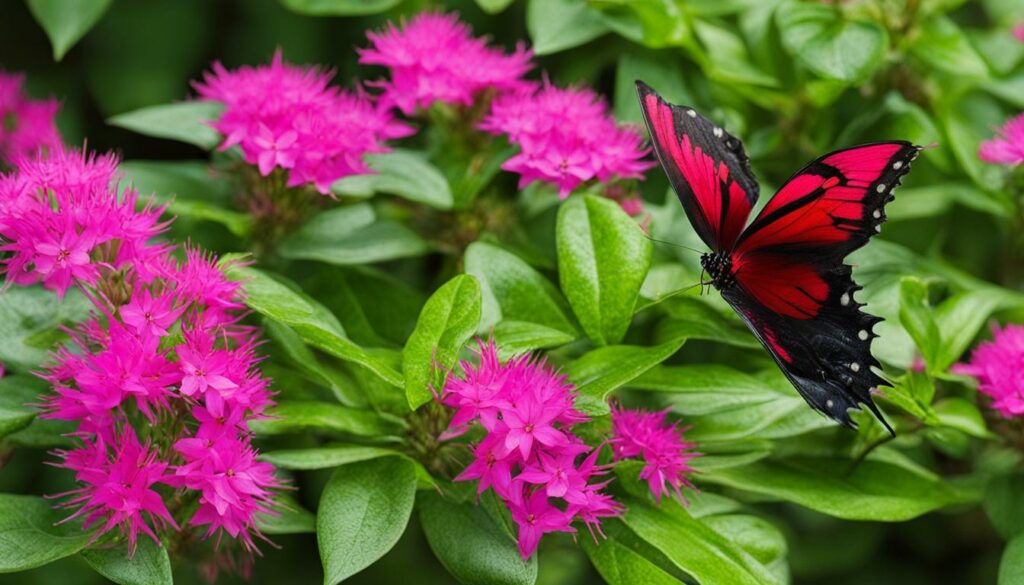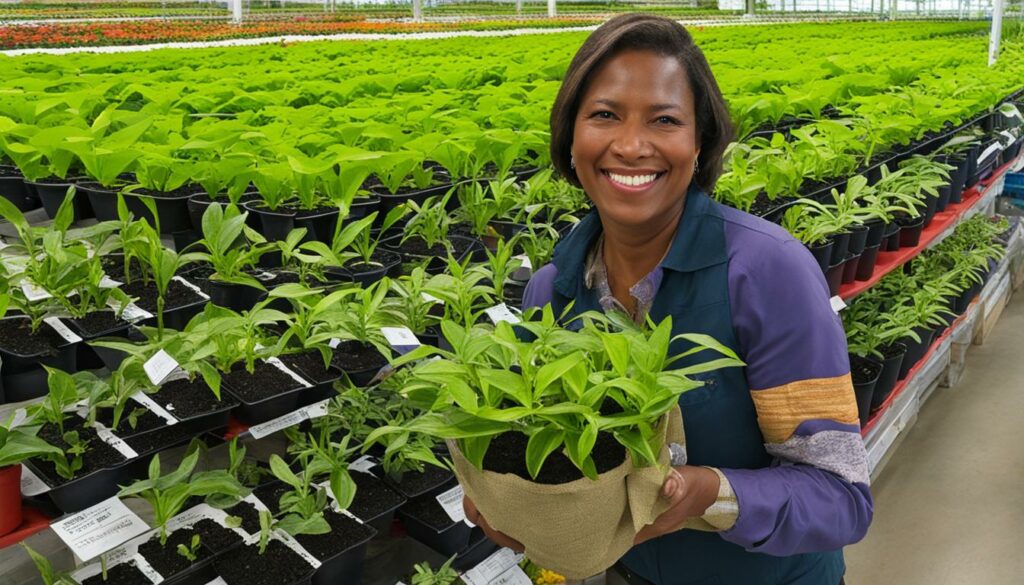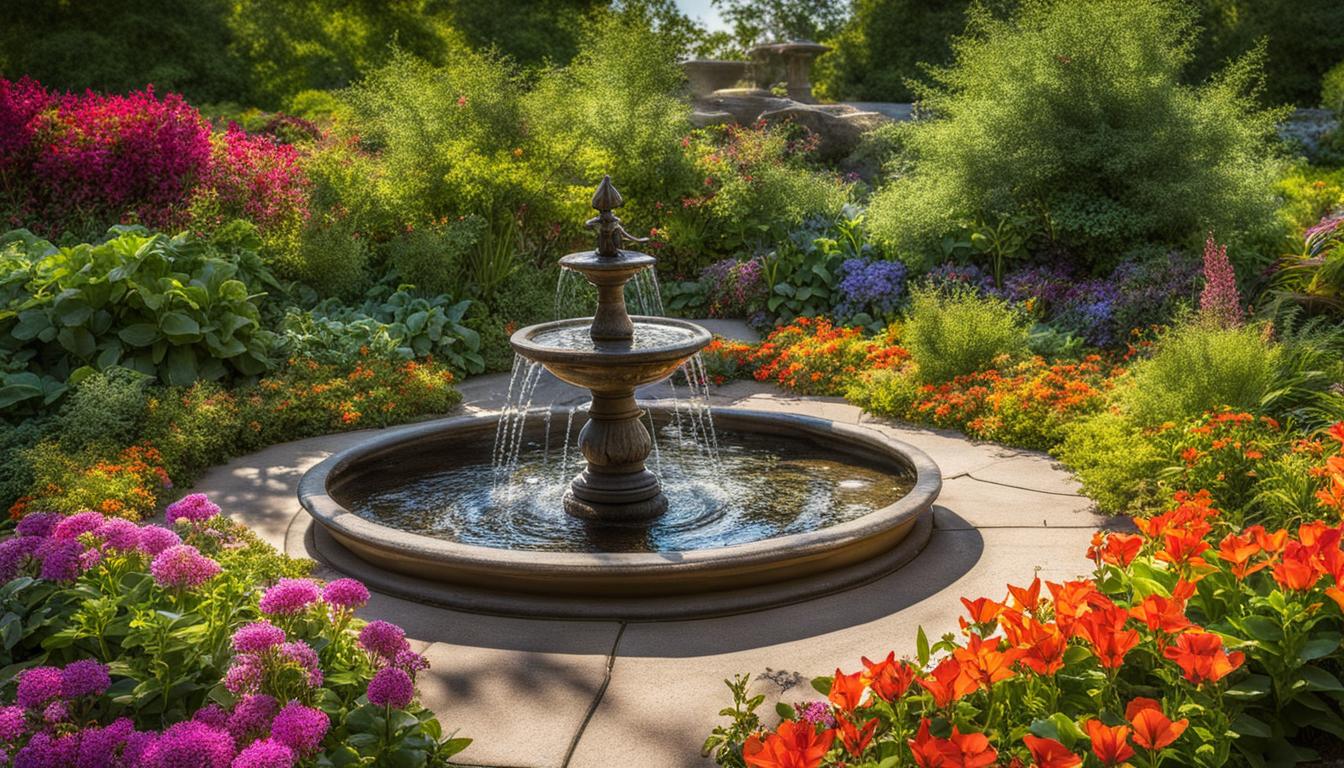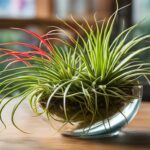Welcome to our Whirling Butterfly Plant Care Guide, where we’ll share everything you need to know to keep your plants healthy and thriving. Whether you’re a seasoned gardener or just starting out, this guide will provide you with essential tips and advice on how to care for your Whirling Butterfly Plants, also known as Gaura (Oenothera lindheimeri).
Gaura is a beautiful and low-maintenance perennial native to North America. Known for its long bloom time and delicate flowers, this plant is sure to add elegance to any garden. In this guide, we’ll cover the best growing conditions for Gaura, tips for pruning and propagating, as well as companion plants to create stunning combinations. So let’s dive in and make your plants happy!
Understanding Gaura (Whirling Butterfly Plant)
Gaura, also known as the Whirling Butterfly Plant, is a low-maintenance perennial that is native to North America. It gets its name from the Greek word gauros, which means superb. Gaura plants have long blooming periods, and their flowers can be white, pink, or a combination of the two. The foliage of Gaura is lance-shaped and may be tinged with pink, cream, or gold.
It is a compact and container-friendly plant, and its wiry flower stems bear many 1-inch flowers with four petals each. Gaura is best planted in the spring or fall and is suitable for USDA growing zones 5 through 9. It thrives in full sun but can tolerate some afternoon shade in hot climates. Gaura plants are drought-tolerant and require excellent drainage. They should be watered infrequently but deeply to help establish their deep roots.
Overall, Gaura is an easy-to-care-for plant that adds a lovely accent to perennial borders and wildflower gardens. Its delicate flowers and airy texture make it a standout in any garden setting.
“Gaura plants have long blooming periods and their flowers can be white, pink, or a combination of the two.”
Characteristics of Gaura plants:
- Low-maintenance perennial
- Native to North America
- Compact and container-friendly
- Lance-shaped foliage with various color variations
- Long blooming periods
- 1-inch flowers with four petals
- Tolerant of full sun and some afternoon shade
- Drought-tolerant
- Require excellent drainage
With its beautiful flowers, easy care requirements, and ability to attract pollinators, Gaura is a fantastic addition to any garden. Whether planted in perennial borders, wildflower gardens, or containers, Gaura’s swaying flowers and delicate appearance will bring a touch of elegance to your outdoor space.
Best Growing Conditions for Whirling Butterfly Plants
Whirling Butterfly Plants, or Gaura, thrive in specific growing conditions that help them flourish and produce their delicate flowers. To ensure the best growth and health for your Whirling Butterfly Plants, consider the following factors:
Sunlight
Gaura plants require full sun to thrive. They need at least 6 to 8 hours of direct sunlight each day to develop strong stems and produce abundant blooms. Planting them in a location with ample sunlight will ensure that your Whirling Butterfly Plants reach their full potential.
Soil
Sandy soil is the ideal choice for Whirling Butterfly Plants. It provides excellent drainage, preventing waterlogged roots that can lead to root rot. If your soil is heavy or clay-like, you can amend it by adding organic matter such as compost or sand to improve drainage. Well-drained soil not only promotes healthy growth but also reduces the risk of diseases caused by excessive moisture.
Watering
While Gaura is drought-tolerant once established, it’s important to provide supplemental water during dry periods, especially in the first growing season. Water deeply but infrequently, allowing the soil to dry out slightly between watering sessions. This encourages the development of a robust root system and helps the plant withstand prolonged periods of drought.
Temperature
Whirling Butterfly Plants are known for their ability to tolerate a wide range of temperatures. They can withstand both extreme heat and humidity, as well as cold temperatures. This makes them suitable for a variety of climate zones, including USDA zones 5 to 9. Whether you live in a hot, dry region or a cooler, more temperate area, Gaura can thrive and add beauty to your garden.
Spacing
When planting Whirling Butterfly Plants, make sure to space them at least 12 inches apart. This allows for proper air circulation and reduces the risk of diseases. Planting them in groups of three or five can create a stunning visual effect and maximize their impact in your garden.
| Conditions | Ideal Range |
|---|---|
| Sunlight | Full sun (6-8 hours per day) |
| Soil | Sandy, well-drained |
| Watering | Deep and infrequent |
| Temperature | Tolerant of extreme heat and cold |
| Spacing | 12 inches apart |
By providing the best growing conditions for your Whirling Butterfly Plants, you can enjoy their long-lasting blooms and vibrant presence in your garden. With proper care and attention to sunlight, soil, watering, temperature, and spacing, your Gaura plants will thrive and bring beauty and joy to your outdoor space.
Tips for Pruning and Propagating Whirling Butterfly Plants
Pruning and propagating Whirling Butterfly Plants, or Gaura, is an important part of their care to ensure a healthy and vibrant plant. Here are some helpful tips for pruning and propagating these beautiful perennials:
Pruning Whirling Butterfly Plants
To maintain a tidy appearance and encourage repeat blooming, it is recommended to prune Whirling Butterfly Plants. The best time to prune Gaura is after the first main bloom in early summer. Cut back the stems to about half their height, just above a leaf node. This will help stimulate new growth and keep the plant bushy and compact. Regular deadheading of faded flowers throughout the blooming season can also promote more blooms.
Propagating Whirling Butterfly Plants
There are a few methods for propagating Whirling Butterfly Plants, including seed propagation and cuttings. However, division can be tricky due to the plant’s long taproot. Propagating from cuttings is generally easier and more successful.
To propagate Gaura from cuttings, select healthy, non-flowering shoots that are about 4 inches long. Cut the stems just below a leaf node and remove the lower leaves. Dip the cut end in rooting hormone to encourage root development. Insert the cutting into a pot filled with well-draining potting mix, keeping it moist until new growth appears. Once the cutting has developed roots, it can be transplanted into a larger pot or directly into the garden.

Summary
- Pruning Whirling Butterfly Plants after the first main bloom in early summer helps maintain a tidy appearance and encourages new growth.
- Deadheading faded flowers throughout the blooming season promotes more blooms.
- Propagating Gaura from cuttings is recommended for successful results, as division can be challenging due to the plant’s long taproot.
- Select healthy, non-flowering shoots for cuttings and use rooting hormone to encourage root development.
- Keep the cuttings moist until new growth appears, then transplant them into larger pots or the garden.
Soil, Watering, and Fertilization for Whirling Butterfly Plants
Whirling Butterfly Plants, or Gaura, thrive in sandy soil and do not require supplemental flower fertilizer. They are drought-tolerant and prefer infrequent but deep watering to help establish their deep roots. Gaura can tolerate extreme heat and humidity as well as cold temperatures, making it suitable for a wide range of climate zones. However, it is important to ensure good drainage, as wet winter soil can be harmful to the plant. Gaura plants do not need dividing to stay vigorous, and too much manure or fertilizer can make the plant floppy. It is best to provide the plant with plenty of sunshine and avoid overwatering.
| Soil | Watering | Fertilization |
|---|---|---|
| Gaura thrives in sandy soil | Infrequent but deep watering | No supplemental flower fertilizer required |
| Well-drained soil is crucial | Establish deep roots | Too much manure or fertilizer can make the plant floppy |
| Good drainage is essential | Prevent wet winter soil |
When it comes to the soil, Gaura plants thrive in sandy soil that provides good drainage. It is important to ensure that the soil is well-drained, as waterlogged conditions can be detrimental to the plant. Gaura plants are drought-tolerant and prefer infrequent but deep watering. This helps establish their deep roots and makes them more resilient to dry periods. However, overwatering should be avoided, as excessive moisture can lead to root rot.
Unlike many other plants, Gaura does not require supplemental flower fertilizer. In fact, too much fertilizer can cause the plant to become floppy. It is best to let Gaura thrive in its natural state without the need for additional fertilization. The plant’s long taproot allows it to access nutrients from the soil, making external fertilization unnecessary.
To summarize, when it comes to caring for Whirling Butterfly Plants, it is important to provide them with sandy, well-drained soil. Watering should be done infrequently but deeply to encourage deep root growth. Avoid overwatering and refrain from using supplemental flower fertilizer. By providing the right soil, watering, and minimal fertilization, you can ensure that your Whirling Butterfly Plants thrive and add beauty to your garden.
Companion Plants for Whirling Butterfly Plants
When it comes to creating a stunning garden display with Whirling Butterfly Plants, or Gaura, the choice of companion plants is crucial. By selecting the right companions, you can enhance the beauty of Gaura and create a harmonious and vibrant garden. Here are some excellent companion plants to consider:
- Rigid and upright flowers like yarrow, ‘Autumn Joy’ sedum, and liatris work well as supportive companions. These plants help keep the delicate flower spikes of Gaura out of the mud and provide a lovely backdrop to highlight its swaying blooms.
- Butterfly weed is another great companion for Gaura. Both plants attract pollinators, creating a haven for butterflies and bees. Plus, their contrasting colors, with Gaura’s delicate flowers and butterfly weed’s bold orange blooms, make for a visually striking combination.
- Globe thistle is an ideal companion plant that shares similar growing conditions and blooming times with Gaura. Its spiky, globe-shaped flowers complement Gaura’s airy texture and add a unique architectural element to the garden.
- Ornamental grasses, such as switchgrass and feather reed grass, provide an excellent backdrop for Gaura’s swaying flowers. Their graceful movement and contrasting textures create a dynamic and visually engaging garden scene.
When choosing companion plants for Gaura, consider the color, height, and growth habit of each plant to ensure a harmonious and balanced composition. By combining Gaura with suitable companions, you can create a garden that is not only visually stunning but also beneficial for pollinators.
“The combination of Gaura and butterfly weed in my garden has been a showstopper. The delicate white flowers of Gaura and the vibrant orange blooms of butterfly weed create a striking contrast that always catches the eye. Plus, the pollinators love it!” – Garden enthusiast

Gaura and Butterfly Weed Combination
| Plant | Gaura | Butterfly Weed |
|---|---|---|
| Height | 15 inches to 4 feet | 2 to 3 feet |
| Flower Color | White, pink | Orange |
| Blooming Time | Spring to fall | Summer to fall |
| Growing Conditions | Full sun, sandy soil | Full sun, well-drained soil |
Where to Buy Whirling Butterfly Plants
If you’re looking to bring the beauty of Whirling Butterfly Plants, or Gaura, into your garden, there are a few places where you can find these lovely perennials. Local nurseries that specialize in native plants, especially in Texas or Louisiana where Gaura is native, are great places to start your search. You can simply search for “native plant nurseries near me” to find a local source.
If you’re unable to find the pure native species, don’t worry! There are also cultivated varieties, or cultivars, of Gaura available in the market. These cultivars offer variations in flower color or foliage and can add an extra touch of uniqueness to your garden. When searching for Gaura plants, you may come across cultivar names like ‘Sparkle White’ or ‘Siskiyou Pink’.
In addition to local nurseries, you can also explore online nurseries and garden centers. Many of these retailers offer a wide variety of plants, including Gaura, for purchase. Simply browse their websites, select the plants you desire, and have them delivered right to your doorstep. However, be sure to verify the credibility and reputation of the online nurseries before making any purchases.
Whether you choose to visit a local nursery or shop online, the joy of having Whirling Butterfly Plants in your garden is just a few clicks or a short drive away. So go ahead, get your hands on these delightful perennials and bring a touch of elegance to your outdoor space!

Table: Comparing Whirling Butterfly Plant Suppliers
| Supplier | Location | Specialty | Availability |
|---|---|---|---|
| Native Plants Galore | Texas | Native plants | In-store and online |
| Butterfly Haven | Louisiana | Butterfly-friendly plants | In-store only |
| Online Plant Paradise | Online | Wide variety of plants | Online only |
| Flower Power Nursery | United States (nationwide shipping) | Perennials and shrubs | In-store and online |
“I found the perfect Whirling Butterfly Plants at Native Plants Galore. Their selection of native species is unmatched!” – Jane Smith, Happy Gardener
Conclusion
Whirling Butterfly Plants, or Gaura, are a beautiful addition to any garden. Their delicate flowers and long bloom time make them a standout perennial. With their low-maintenance nature, they are perfect for both beginners and experienced gardeners.
These plants thrive in full sun and sandy soil, but they are also tolerant of extreme heat, drought, and cold. This versatility makes them suitable for various climates. To keep your Gaura plants happy and thriving, remember to deadhead the flowers, provide supplemental water during dry periods, and cut back the stems in early spring. These simple care practices will help maintain the plant’s health and vibrant appearance.
In addition to their beauty, Gaura plants can attract pollinators to your garden. Consider pairing them with companion plants such as yarrow, butterfly weed, or ornamental grasses to create stunning combinations and provide a habitat for beneficial insects.
Whether in a perennial border, wildflower garden, or container, Gaura adds a touch of elegance and movement with its swaying flowers. By following this comprehensive Whirling Butterfly Plant Care Guide, you can ensure that your Gaura plants thrive and bring joy to your outdoor space.
FAQ
When is the best time to plant Whirling Butterfly Plants?
Whirling Butterfly Plants are best planted in the spring or fall.
What kind of soil do Whirling Butterfly Plants prefer?
Whirling Butterfly Plants prefer sandy soil with good drainage.
Are Whirling Butterfly Plants drought-tolerant?
Yes, Whirling Butterfly Plants are tolerant to drought once established.
What pests are Whirling Butterfly Plants prone to?
Whirling Butterfly Plants can be prone to aphids, but they can be resolved with insecticidal soap.
How do you propagate Whirling Butterfly Plants?
Whirling Butterfly Plants can be propagated from seed or cuttings. Division is tricky due to their long taproot.
How should I care for Whirling Butterfly Plants in the winter?
Whirling Butterfly Plants are cold-tolerant, but providing some protection, such as mulch, can be beneficial in harsh winters.
Can Whirling Butterfly Plants tolerate shade?
While Whirling Butterfly Plants can tolerate some afternoon shade, they thrive and bloom best in full sun.
How often should I water Whirling Butterfly Plants?
Whirling Butterfly Plants should be watered infrequently but deeply to help establish their deep roots.
Where can I buy Whirling Butterfly Plants?
Whirling Butterfly Plants can be found at local nurseries specializing in native plants or online nurseries and garden centers.





